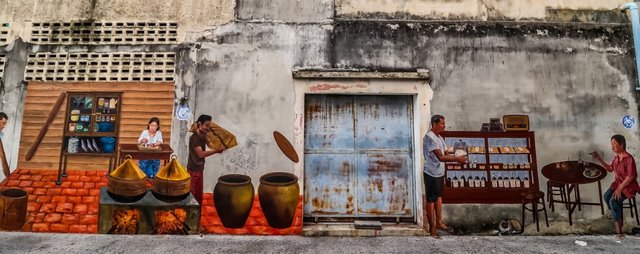Songkhla's Street Art
In 2016 the provincial governor of Songkhla Songphol Swadtham decided that 15 murals should be installed on three streets in the Old City area (Nok Road, Nakhon Nai Road and Nang Ngam Road) as part of a project to increase tourism. The aim was to emulate the positive effect of the Street Art installed in Penang as part of the George Town Festival in 2012. Other cities in Thailand, in particular Phuket Town, have tried the same strategy with good results in terms of increasing the number of visitors.
Most of the street art in Songkhla can be found in the "Songkhla Old Town" in southern Thailand near Hat Yai, it has a growing collection of good quality murals painted on the side of the buildings. An area that houses buildings up to 200 years old inhabited by a dense community of largely Thai-Chinese and Muslim-Thai people, many of whom came to Songkhla in the 18th and 19th centuries, when it was a prosperous seaport and important with trade links throughout Asia.
These early murals were designed by art students from Silapakorn University and Thaksin University, with the assistance of staff from Hat Yai's Magic Eye 3D Museum.
A second distinguishing feature of the South East Asian street art movement is that the argument about the murals refers to the history and culture of the place where the artwork is located, and most importantly, the argument is often mundane day to day activities of local residents. Mundane activities like eating a meal, going for a coffee, traveling around the city and so on are what give a place its unique character as much as the physical architecture of an urban landscape.
A third feature of the Southeast Asian art movement that is evident in Songkhla's street art is the technique of linking the image to the location using real three-dimensional objects as part of a two-dimensional representation. Painted cats cling to real window frames and paintings of street corner coffee stalls are actually painted on either side of a physical street corner.
A fourth feature is the use of humor. Many of Songkhla's murals are whimsical. Most people in Southeast Asia try not to take everything in life too seriously, and neither do Southeast Asian street art.
Songkhla's murals all have significance, and for visitors who come out of them the meaning offers insights into the city's history and identity. For example, the large mural of an old merchant ship remembers that Songkhla used to be a large shipping port; the mural of an RAF bomber recalls that Songkhla was where the Japanese invaded Thailand a launch site for attacks on British colonies in the Malay Peninsula and Burma; Nang Talung's robed shadow puppet mural is reminiscent of an ancient cultural identity of southern Thailand.
In terms of the themes and techniques used to create the murals, Songkhla street art is part of a larger emerging Southeast Asian street art movement that is most evident in urban centers in Malaysia and Thailand, but slower to grasp in other mainland Southeast Asian countries such as Laos, Vietnam and Cambodia, where authorities have been reluctant to see the benefits of good street art in transforming blighted areas. One of the important characteristics of the South East Asian street art movement is to overturn the belief that public art on walls is an indicator of urban decay; in cities like Songkhla and Ipoh street art was part of an attempt to rejuvenate cities by slowing down their local economies.









